Welcome to Gotham Calling’s 200th post!
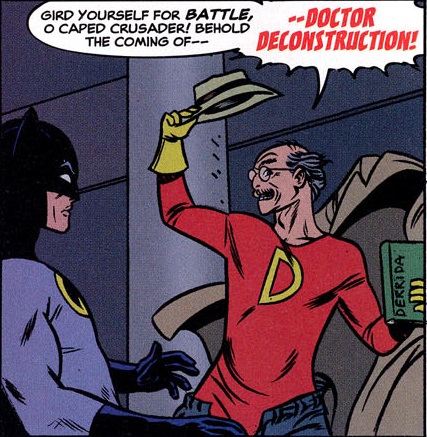 Solo #7
Solo #7
Back when we reached the first hundred posts, Zack Snyder’s Batman v Superman: Dawn of Justice was about to come out and I wrote about a handful of oddball villains whom I guessed wouldn’t be showing up in the film. It was a different era: since then, we’ve had The LEGO Batman Movie, so now it seems that pretty much any character – no matter how strange or obscure – has a chance to appear on the big screen, at least in a cameo. (Between the first couple of LEGO movies and Ready Player One, there seems to be no limit to the amount of pop culture Easter eggs Warner is willing to cram into its films.)
This is the kind of thing that fills my geeky heart with joy, since I have an unabashed fondness for all the losers in Batman’s rogues’ gallery… I just love the notion that for every deranged criminal that makes it big – like the Joker and Two-Face – there are a dozen loons with preposterous gimmicks desperately trying to make a name for themselves.
For instance, take Mr. Polka-Dot (aka Polka-Dot Man), who has become a poster boy for this type of character:
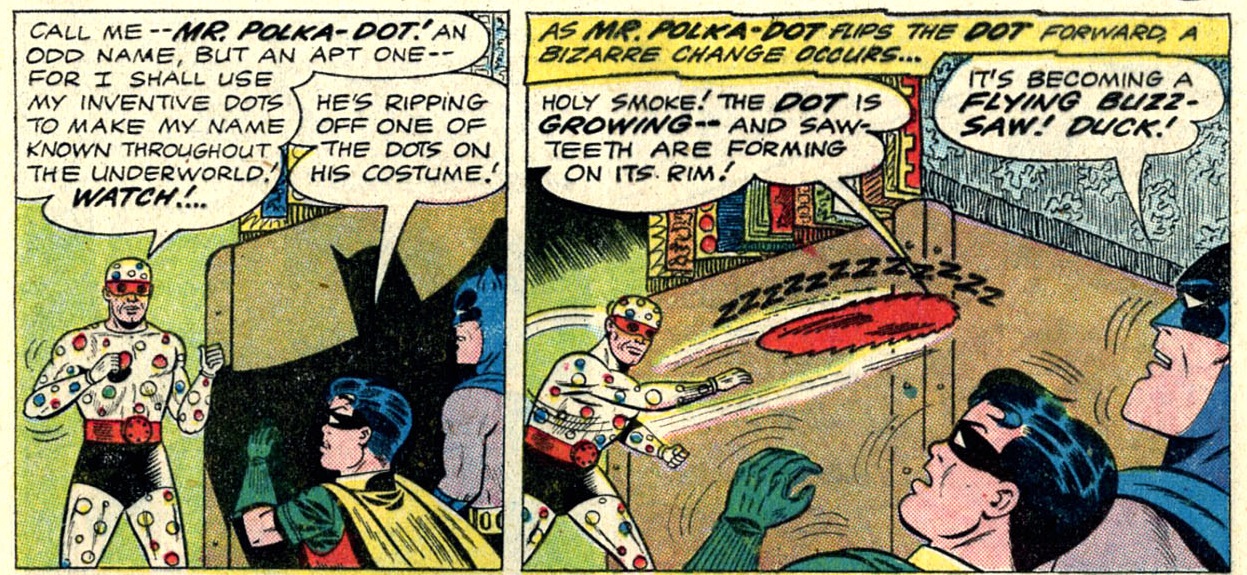 Detective Comics #300
Detective Comics #300
Created in the early 1960s by writer Bill Finger and artist Sheldon Moldoff (with inks by Charles Paris), Abner Krill decided to turn harmless dots into menacing weapons of crime. Thus, one of the colorful dots in his funky costume becomes a buzzsaw, another one becomes a flying saucer, yet another one becomes a tiny sun… Moreover, the targets of his robberies are all specifically related to dots and spots, including a maharaja who owns a leopard and a map company where cities are represented by dots on maps.
If this premise sounds goofy, that’s because it is: the story that introduced Mr. Polka-Dot (‘The Bizarre Polka-Dot Man’) came out during the Caped Crusader’s infamous Great Scott period, at the height of the Silver Age. With no clear motivation for the villain or explanation of how his devices worked, the whole thing was almost abstract, combining baffling lines with psychedelic images (like when Robin was attacked by dots that turned into hovering dismembered fists).
This is one of those tales in which you just know the Dynamic Duo is going to use the villain’s theme against him and part of the fun is trying to figure out how they’ll pull it off. There is also a puzzle in the pattern of the crime spree, which the reader is directly invited to solve. The final page is a gloriously pun-full read – besides Batman’s obvious one-liners while punching the wannabe crime lord (‘Right on the dot! By now, you should be seeing spots before your eyes, Mr. Polka-Dot!’), we get this delightful panel:
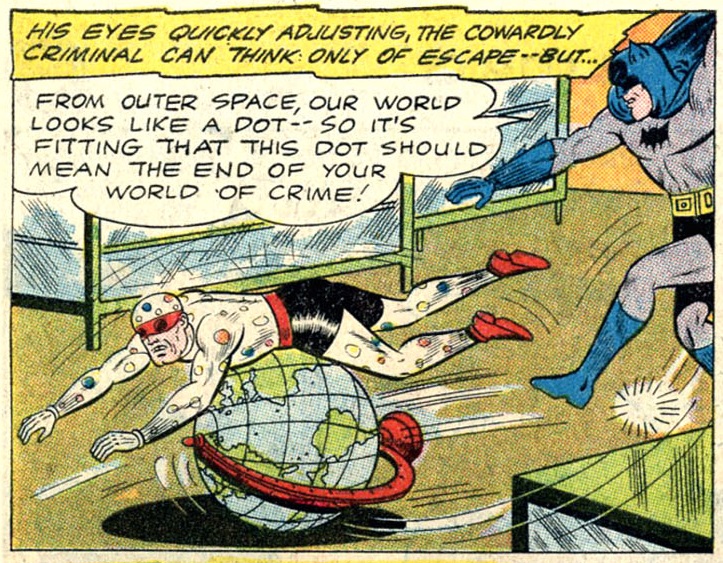 Detective Comics #300
Detective Comics #300
Although this was the only proper comic book story where the Polka-Dot Man served as the Caped Crusader’s main antagonist, he is probably the least obscure villain on our list. The character’s ridiculousness ended up working to his advantage, as he became a running joke in Batman comics. Most remarkably, he has been known to show up in books written by Chuck Dixon, in the most demeaning situations… Abner Krill gets a serious beating from Harvey Bullock on the opening pages of the excellent GCPD mini-series. Likewise, he is attacked as part of a background gag in the saga of the equally lame Killer Moth:
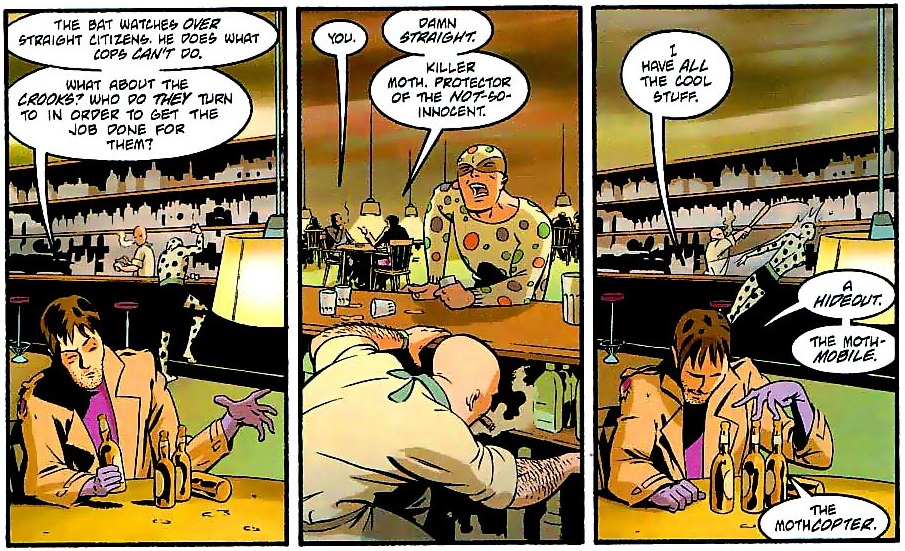 Batgirl: Year One #5
Batgirl: Year One #5
(Apparently, the Polka-Dot Man continued to hang out at the same bar, as seen in Nightwing: Year One, where he got yet another beating there.)
One of my favorite cameos takes place in ‘Love at First Mite,’ where Sholly Fisch briefly rebooted the character with even more outlandish weapons (‘Should I shrink you with my microdot? Trap you in the internet with my dot-com? Wipe your memories with my forget-me-dot?’).
Together with Kite-Man, Crazy Quilt, and the Condiment King, this remains one of the go-to villains when creators lazily want to illustrate a failed member of Batman’s rogues’ gallery…
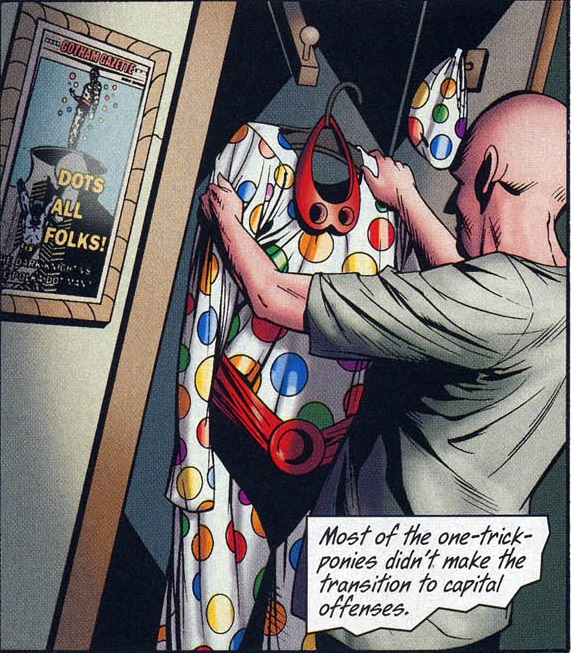 Widening Gyre #4
Widening Gyre #4
Notably, Mr. Polka-Dot appeared in the 2009 mini-series Final Crisis Aftermath: Run, a dark comedy about second-rate villains, in which he met his suitably pathetic demise as his head got squished by a manhole cover!
One character who debuted around the same time as the Polka-Dot Man – also designed by Sheldon Moldoff (with inks by Joe Giela) – and whom I’m quite fond of is the Monarch of Menace (aka the King of Crime, aka the Royal Rogue). This criminal used technology shaped like royal symbols in order to physically force people to act respectful and subservient:
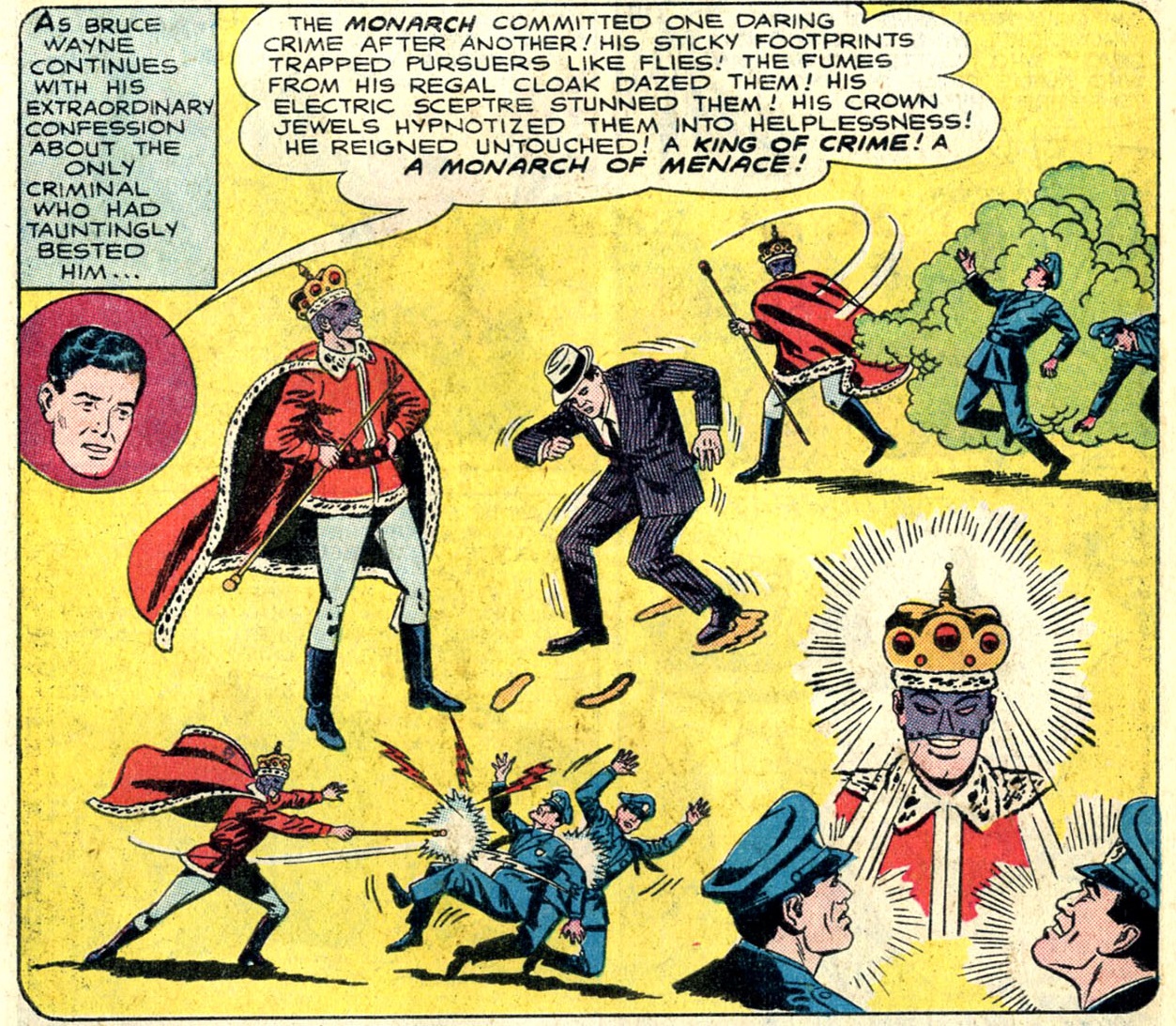 Detective Comics #350
Detective Comics #350
The Monarch of Menace first showed up in a 1966 story penned by Bob Kanigher, in which Batman seemed obsessed with the Royal Rogue, who had disappeared after having established his ‘reign of crime’ (the Caped Crusader even had a framed picture of him in the Batcave, because why wouldn’t he). When the Monarch of Menace apparently returned, Robin quickly captured him, but it turned out to be the Monarch’s son clumsily trying to follow the father’s footsteps (in what can be read as a parody of the notion of hereditary power). My favorite bit occurred early on, as Batman athletically fought a group of henchmen… The villain mused: ‘Perhaps I ought to make you my court acrobat?’ and the Dark Knight replied: ‘The only court that interests me is the one I’m going to put you in – the court of law!’
The King of Crime returned in 1981, as the main villain of ‘While the Bat’s Away…’ (plot by Bob Rozakis, script by Roy Thomas, art by Jose Garcia-Lopez and Frank McLaughlin). Taking advantage of the fact that the Dark Knight was out of town – presumably in the globetrotting adventure ‘The Lazarus Affair’ – the Monarch of Menace claimed to have captured Batman and demanded a tribute from Gotham’s underworld (10% of the loot from each heist) in exchange for keeping the crimefighter out of circulation. This is quite a nice issue, not only because it looks great (Jose Garcia-Lopez is one of the all-time masters of elegant depth and dynamism), but because the rumors of Batman’s disappearance encourage all sorts of small-time crooks to try their luck in Gotham, which serves as a pretext to bring back Z-list villains like the Bouncer, Spellbinder, and Cluemaster.
Moreover, the issue features several fun moments as the Caped Crusader and the Monarch of Menace try to out-quip each other. At one point, the former taunts the latter: ‘You’ll never make it in the underworld wearing those threads, anyway… Burger King will sue you for trademark infringement!’ Later, he tells his foe: ‘You talk big, Monarch – for a guy who lets others do his dirty work for him.,’ to which the Royal Rogue poignantly retorts: ‘Is that not traditionally the way of kings, varlet?’
Speaking of royalty, let us not forget the Element King:
 Legends of the Dark Knight (v2) #63
Legends of the Dark Knight (v2) #63
Simon Majors was a brilliant professor of chemistry who began studying alchemy and became obsessed with the discovery of the philosopher’s stone. In order to finance his research, he planned a series of robberies and eventually got a costume and called himself the Element King, before being put away by Batman and Robin. After several years in prison, he was released and – in the storyline ‘Elements of Crime’ – came out of retirement for an element-themed crime spree that culminated in an alchemist ritual at the Pentagon.
The Element King may sound like another kooky Silver Age creation, but he was actually first brought to the page in 2013, courtesy of Mike W. Barr and Tom Lyle. The joke is that he was clearly modelled after those old, cheesy villains, so it felt like you were reading the reboot of a character that didn’t exist before. Mike Barr, who always had a knack for this kind of metafictional interplay, masterfully combined a modern storytelling style with a classically constructed plot, including charming tropes such as ingenious escapes from convoluted deathtraps and scenes in which the Dynamic Duo jointly deciphered weird clues deliberately left by the criminal, for whatever reason. (In a subtler nod to 60s’ comics, the tale also featured a cameo by Simon Stagg, supporting character in Metamorpho, the Element Man.)
Sure, as a villain the Element King may not have much potential beyond mere pastiche and, in any case, he met quite a grisly fate in this story (a loser until the end). Yet it would be fun if future flashbacks retroactively incorporated him into the Dark Knight’s past and memories… If nothing else, this could allow for more fight scenes with the Dynamic Duo kicking butt while making outrageous puns about osmium and potassium.
In a similar gesture to the creation of the Element King, Karl Kesel and Dave Taylor – with inks from Robert Campanella and colors from Alex Sinclair – created Illuminata as a throwback to the same kind of colorful, one-shot villains of Batman’s past…
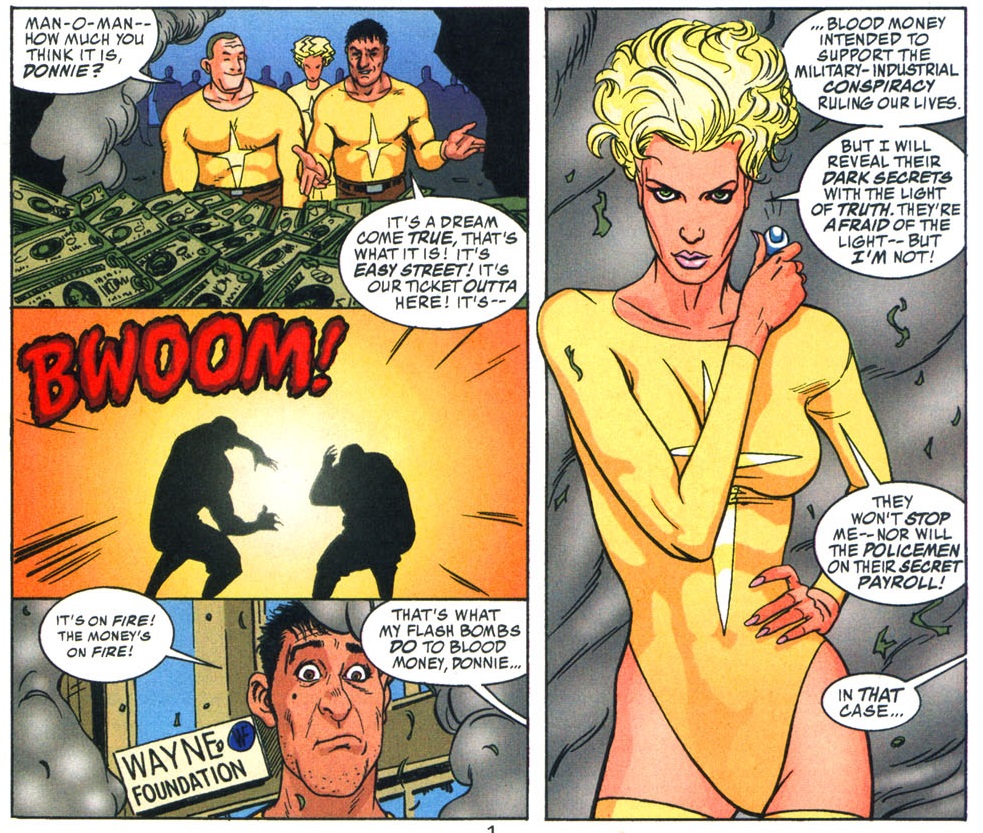 World’s Finest (v2) #3
World’s Finest (v2) #3
Illuminata was a light-themed terrorist armed with incandescent flash bombs whose motivation was to shed light on the conspiracy that secretly rules the world. She showed up in an issue of the nifty World’s Finest limited series published in 1999, looking at the evolution of the friendship between the Caped Crusader and the Man of Steel throughout different eras of the characters’ histories. In this story (‘Light in the Darkness’), Superman – while pretending to be Clark Kent pretending to be Superman – went undercover into Arkham Asylum to write an exposé on the place. It just so happened that, while he was there, Illuminata managed to escape from her cell by grabbing a guard’s flashlight (‘And you used it to blind him and take his passkeys?,’ asks the Man of Steel… to which she replies that, no, actually she beat the guard unconscious with it!). She proceeded to organize a massive prison break in order to highlight Arkham’s terrible conditions.
Unfortunately for her, though, the Joker then decided to help Illuminata see better… by taking off her eyelids! The series thus strikingly illustrated the transition from the brighter Batman comics of yesteryear into a darker era:
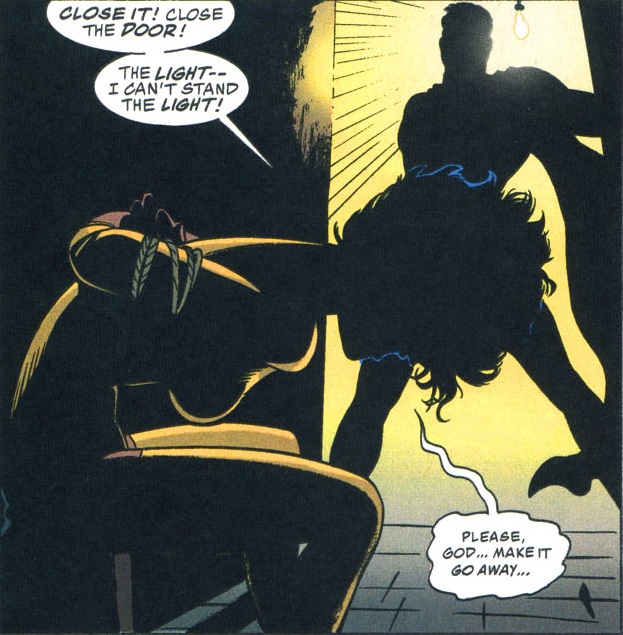 World’s Finest (v2) #3
World’s Finest (v2) #3
I just can’t get enough of these self-reflexive touches…
Which leads us to Mr. Nice, who was a member of a trio of hilarious thieves created by the team of Kelley Puckett, Mike Parobeck, Rick Burchett, and Rick Taylor in ‘The Last Riddler Story,’ one of the coolest issues of The Batman Adventures (a series in which most issues were pretty awesome anyway):
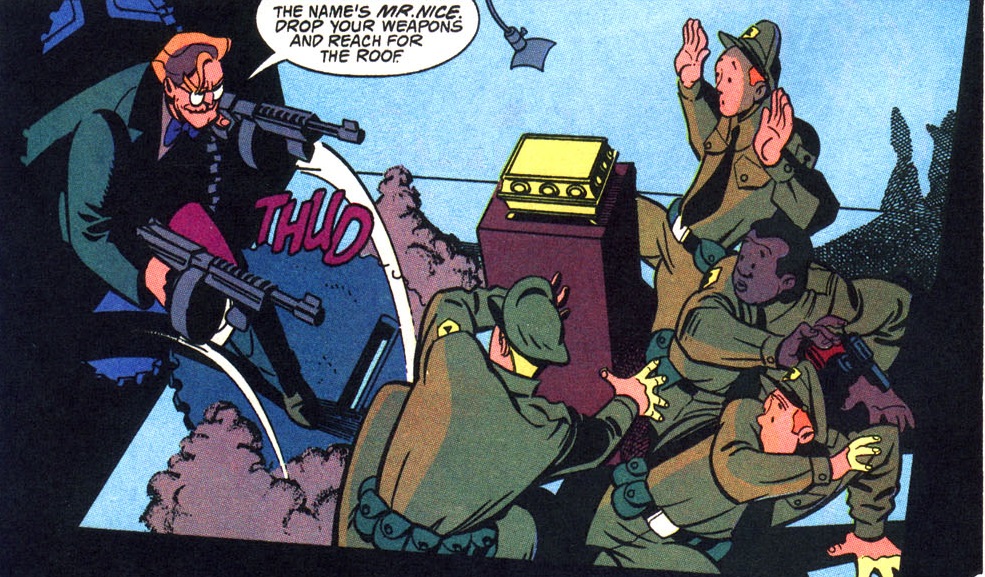
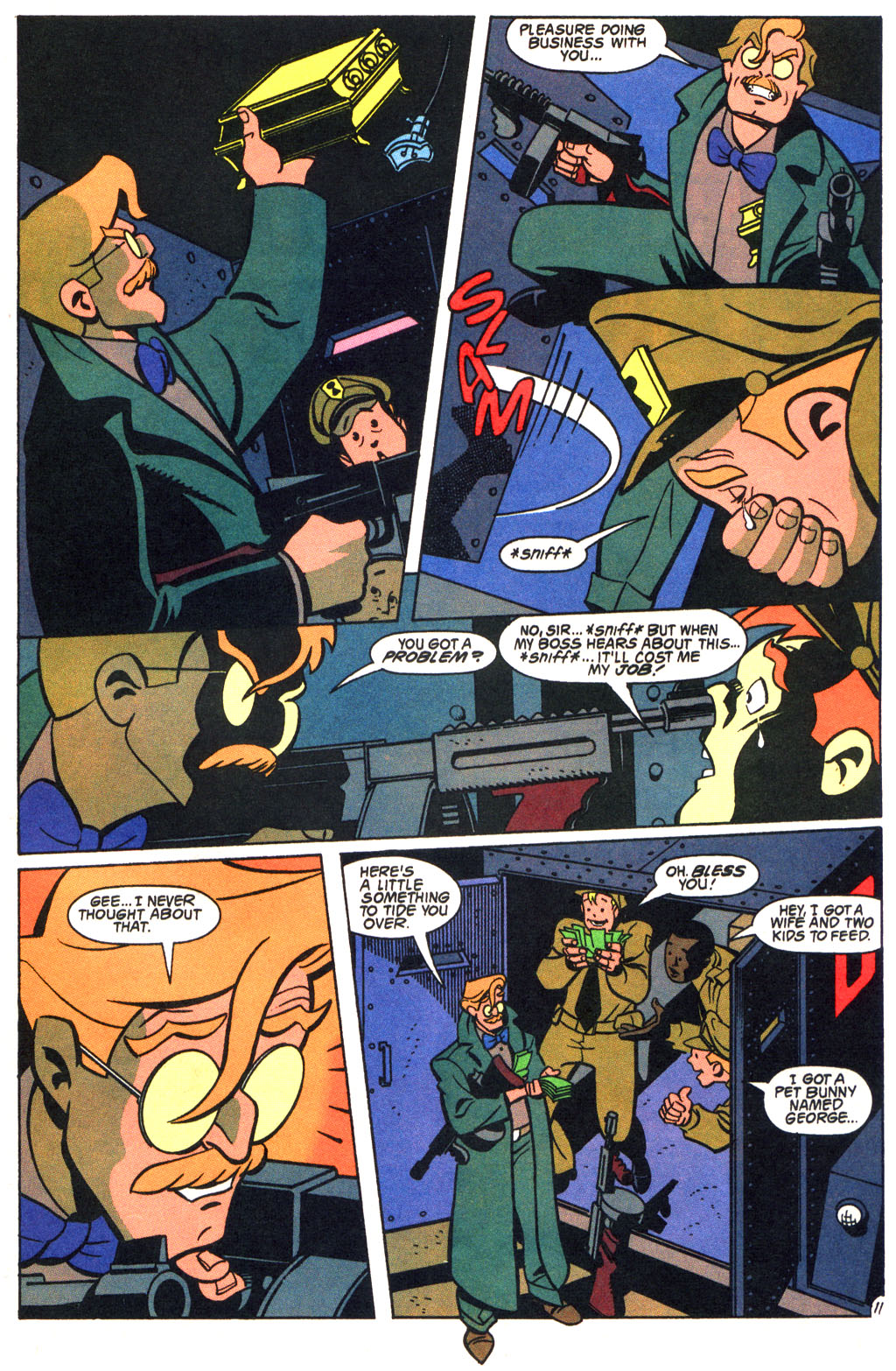 The Batman Adventures #10
The Batman Adventures #10
Part of the joke – as you can tell from the gag above – was that, even though Mr. Nice had the skills to be a great robber, he was too swell a guy to fully go through with his heists. The other part of the joke was that Mr. Nice was modelled after DC editor Archie Goodwin (who edited much of Legends of the Dark Knight, for example), just like his two partners – the obsessive planner Mastermind and the know-it-all Perfesser – were modelled after editors Mike Carlin and Denny O’Neil.
The trio proved to be popular enough to earn a few sequels, with Puckett, Parobeck, and Burchett returning to the characters in ‘Smells Like Black Sunday’ and ‘Natural Born Loser’ (this one with Glen Murakami on colors), both fast-paced screwy comedies that would’ve made the Marx Brothers proud. In the former, Mr. Nice promises his partners to stop being nice for a day and then goes on to rob a nuclear arsenal, only to be defeated by an adorable puppy. In the latter, we are treated to the trio’s origin stories, including Mr. Nice’s background as a kids’ show host who just happened to have a talent for violence.
After Archie Goodwin passed away, in 1998, Kelley Puckett wrote a final comic about this trio – a lovely tribute to Goodwin, appropriately called ‘The End,’ in which Mr. Nice agreed to pull one last job before moving to an unknown country to help out a child leper colony. The story was full of touching meta-commentary, from the opening splash page (with Batman looking in the direction of the reader while proclaiming: ‘Nobody’s going to die here.’) to the scenes in which Mr. Nice said farewell to Mastermind and the Perfesser.
That said, for the most part the issue was just as packed with slapstick as the other ones, down to Rick Burchett’s cover, which riffed on Mad #1…
(By the way, I’m pretty sure one of the antagonists in Shadow of the Bat #31 was a nod to Archie Goodwin as well!)
I’ll finish with the death-themed villain Mortimer Kadaver, another personal favorite of mine. He was introduced in 1988, in the kickass three-parter ‘Night People,’ by Alan Grant and Norm Breyfogle (John Wagner is also officially credited, but I think this was after he had stopped working for Detective Comics). Mort was essentially a psychopath whose morbid fetish perfectly embodied the twisted sensibility of the Grant/Breyfogle run…
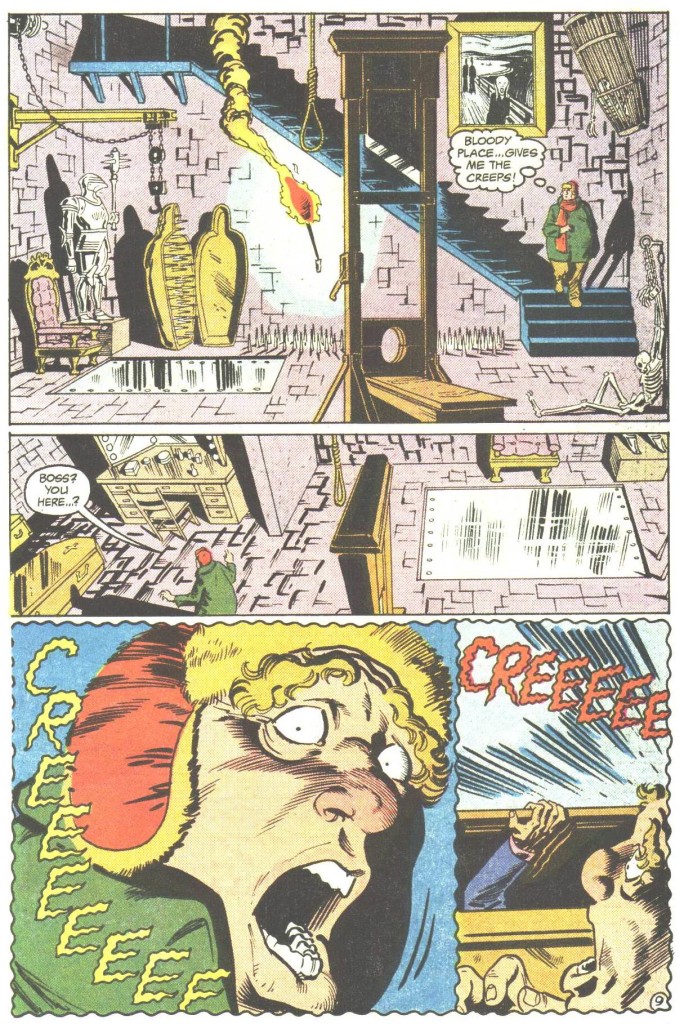
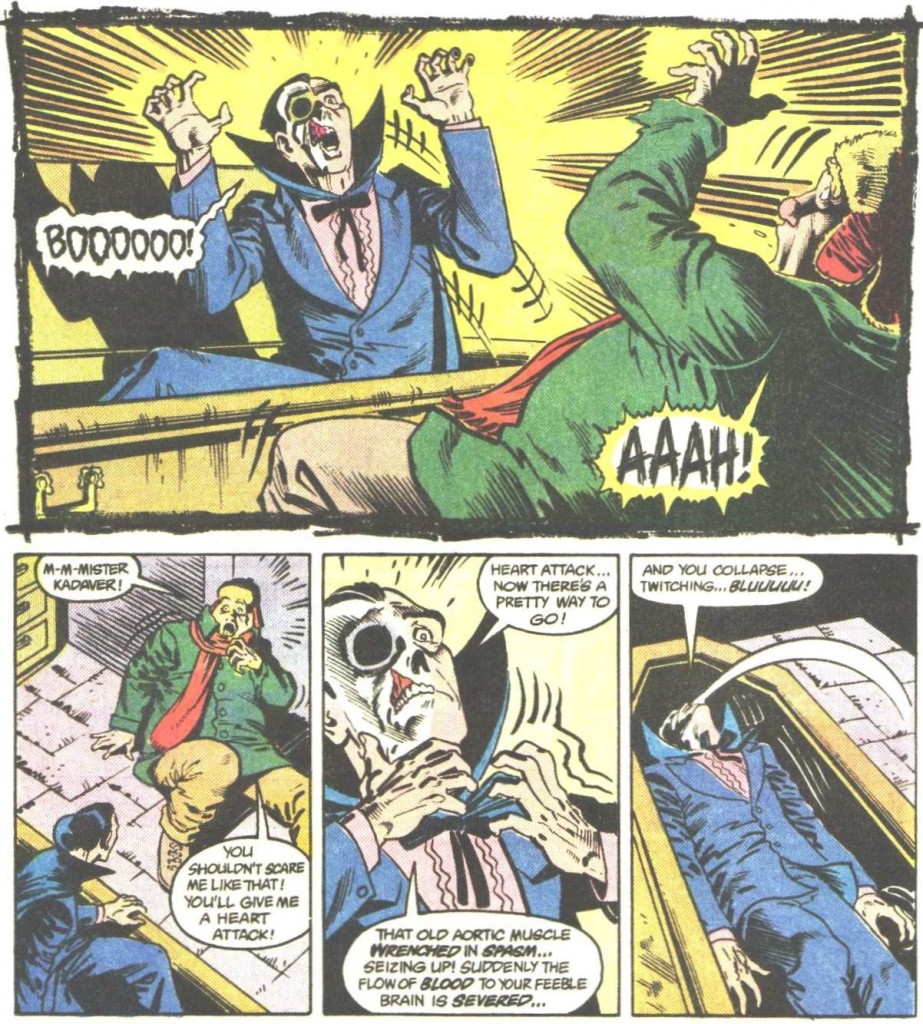 Detective Comics #588
Detective Comics #588
Even though he didn’t catch on as much as other villains created during this run – such as Ratcatcher and the Ventriloquist – Mortimer Kadaver played a role in some fine comics. After ‘Night People,’ he appeared in ‘Snow and Ice,’ where he helped the Penguin fake his own death. As usual, the swash of Norm Breyfogle’s art knocked it out of the ballpark and the whole thing was peppered with Alan Grant’s surreal dark humor (including the Penguin’s bizarre final request that everyone at the funeral give a loud, bird-like squawk over his grave). Kadaver seemingly died in this story, shot in the head – amusingly, he died begging for his life… or, at least, for a less undignified death!
I suppose Grant couldn’t get enough of Mort, as he brought him back two years later, in Shadow of the Bat #11-12 (now with art by Vince Giarrano). The doctors had somehow managed to save Kadaver from the bullet in the head, but they had also discovered a brain tumor that would soon kill him. This turned out to be the character’s final appearance (although he was behind the scenes in Shadow of the Bat #25) and talk about going out in style – determined to take as many people with him as possible, Kadaver came up with a plan to infect Gotham City with the pneumonic plague!
However, because this was Gotham after all, he was ultimately stopped by an even goofier villain:

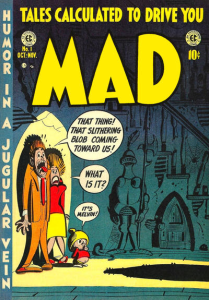
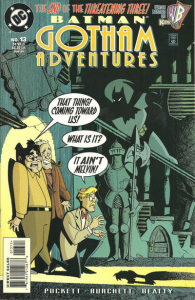
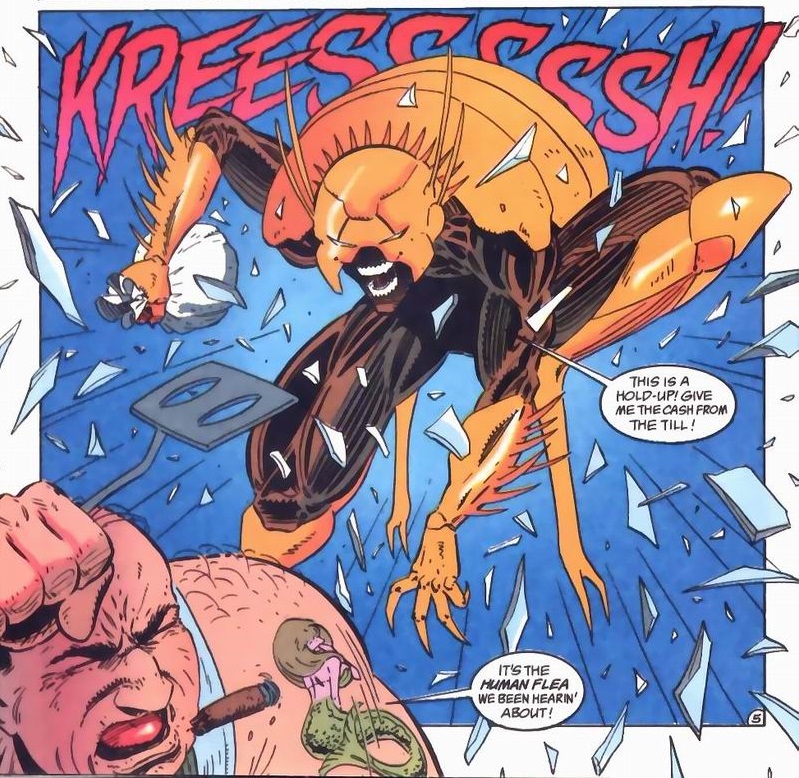
I love the one-shot villain from Detective Comics 630 – no, not the multi racial Siamese twins, but Stiletto, the suave assassin whose voice had a mysterious, persuasive power. That’s one villain I always thought had potential from more stories.
Yes, that whole issue (hell, that whole Milligan run) is pretty neat… and it did leave the door open for a sequel. I suppose Cypher (from Dixon’s run) ended up covering similar ground.
Mr. Nice also got a cameo in a Legends of the Dark Knight issue, in Steve Englehart’s ‘Primal Riddle’ storyline. There he was shown in the Batcomputer as being currently held in Belle Reve Prison.
I’m kind of fond of Tiger Moth, Silken Spider and Dragon Fly, who all debuted in the same story as Poison Ivy, but… suffice to say they didn’t make it as far as she did. They were reimagined Post Crisis as mere singers during Ala Grant’s ‘Poison Ivy Year One’ book, but Grant Morrison and Paul Dini would recast them as villainesses again during The Resurrection of Ra’s al Ghul. I don’t think we’ve seen them ever since.
Tiger Moth, Silken Spider, and Dragon Fly are totally getting the spotlight in post #300…